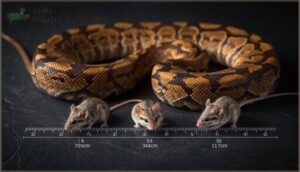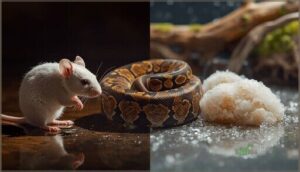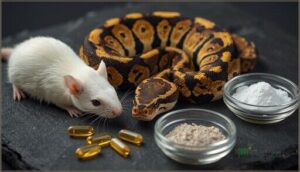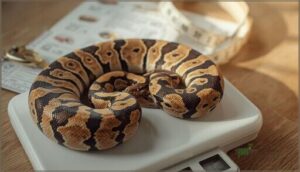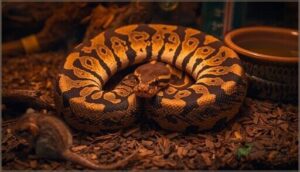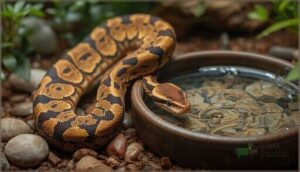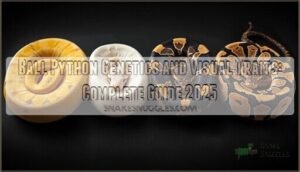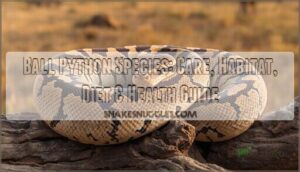This site is supported by our readers. We may earn a commission, at no cost to you, if you purchase through links.
Your ball python won’t thrive on pet store advice alone. Most new keepers start with good intentions but make critical mistakes in prey selection, sizing, or feeding frequency—choices that compound over months into obesity, nutritional deficiencies, or chronic feeding refusal.
The evidence is clear: over 90% of captive ball pythons can thrive on frozen-thawed rodents when you match prey size to body diameter and adjust feeding intervals as your snake matures.
Getting the fundamentals right from day one prevents the digestive complications and metabolic issues that plague improperly fed specimens. Understanding proper ball python diet recommendations transforms feeding from guesswork into a reliable system.
Table Of Contents
- Key Takeaways
- What Do Ball Pythons Eat in Captivity?
- Choosing The Right Prey Size
- How Often Should You Feed Ball Pythons?
- Live Prey Vs. Frozen-Thawed Rodents
- Do Ball Pythons Need Vitamin Supplements?
- Recognizing and Preventing Obesity in Ball Pythons
- Troubleshooting Common Feeding Problems
- Water Requirements for Ball Pythons
- Frequently Asked Questions (FAQs)
- Conclusion
Key Takeaways
- Ball pythons thrive on frozen-thawed rodents sized at 1–1.5 times their body width (or 10–15% of body weight), with feeding frequency shifting from weekly for hatchlings to every 2–3 weeks for adults to prevent obesity and metabolic complications.
- Frozen prey eliminates 90% of bite injuries and disease transmission risks compared to live feeding, while proper thawing and warming to 98.6°F prevents regurgitation and ensures safe digestion.
- Most feeding refusals stem from environmental stress—incorrect temperatures outside 88–92°F, humidity below 60%, or handling within 48 hours post-feeding—rather than genuine health problems.
- Overfeeding causes fatty liver disease that can cut lifespan in half, making weight-based feeding schedules and monthly body condition assessments critical for long-term health.
What Do Ball Pythons Eat in Captivity?
Ball pythons are obligate carnivores, which means their entire diet consists of whole prey animals. In captivity, you’ll feed them rodents almost exclusively, though a few alternatives exist for specific situations.
Let’s look at what goes into your ball python’s food bowl and how to choose the right prey for your snake.
Rodents as Primary Food Source
Rodents form the nutritional foundation of your ball python diet. Over 90% of captive pythons thrive on frozen-thawed rodents—primarily mice and rats—which deliver complete protein profiles and support healthy neurogenesis. This prey variety mirrors their wild feeding behavior while eliminating injury risks.
Proper feeding techniques, including correct prey size and feeding frequency, guarantee ideal snake digestion and nutrient balance throughout your python’s life. For ideal health, it’s vital to follow a complete food guide to determine the best diet for your ball python.
Mice Vs. Rats: Which to Choose
Once you’ve settled on rodents, the mice versus rats debate becomes your next priority. Rats offer twice the calcium and enhanced long-term nutrition for your growing ball python, while mice work well for hatchlings but create feeding challenges as your snake matures.
Consider these prey nutrition factors:
- Adult rats support better snake growth and bone density than mice
- Feeding strategies shift from weekly mice to biweekly rats as your python ages
- Nutrient balance improves with rats, reducing dietary diversity concerns
For ideal growth, understanding rat feeding benefits is essential.
Alternative Prey Species
While rats remain ideal, your ball python can thrive on alternative whole prey species like African soft fur rats, quail, and chicks. Wild ball pythons consume birds frequently—males in Nigerian studies ate avian prey 70.2% of the time.
These mammalian choices and avian options support nutritional balance when properly sized. Rotate novel prey species gradually to improve prey acceptance, always sourcing from disease-free suppliers for safety.
Choosing The Right Prey Size
Getting prey size right is one of the most important aspects of keeping your ball python healthy. Too small and your snake won’t get adequate nutrition; too large and you risk regurgitation or injury.
Let’s break down the key sizing guidelines you need to follow.
The 1-1.5x Body Width Rule
Prey size guidelines form the foundation of safe feeding practices for your ball python. The prey item’s girth should match or slightly exceed your snake’s widest body point—usually 1 to 1.5 times that diameter.
- Measure the rodent’s body width, not its length or weight
- Oversized prey increases regurgitation risk by 23% in recent studies
- Proper sizing prevents digestive health complications and aids obesity prevention
Weight-Based Feeding Guidelines
A second approach focuses on weight-based feeding guidelines rather than visual measurement alone. Your ball python’s prey should weigh 10–15% of its total body weight for ideal health and obesity prevention.
For a 400-gram snake, that’s roughly 40–60 grams per meal. This weight-based feeding method helps maintain proper snake growth rates while meeting nutrient requirements throughout each life stage.
Age-Specific Prey Sizing
Your ball python’s growth stages demand different prey ratios to support ideal snake nutrition. These size guidelines and feeding charts help you select appropriate prey size at each life stage:
- Hatchlings (0–1 year): Feed 10–15% body weight weekly—usually 8–15g prey items for steady development.
- Juveniles (1–3 years): Provide juvenile portions at 7% body weight every 14 days.
- Adults (3+ years): Offer 5% body weight every 21–30 days following weight-based feeding guidelines.
How Often Should You Feed Ball Pythons?
Feeding frequency changes dramatically as your ball python grows, and getting it right is essential for healthy development. Hatchlings need frequent meals to fuel rapid growth, while adults thrive on much longer intervals between feedings.
Let’s break down the schedule by age so you know exactly when to offer your snake its next meal.
Hatchling Feeding Schedule (Every 5-7 Days)
Your hatchling feeding schedule sets the foundation for healthy snake development. Feed your hatchling ball python every 5 to 7 days to support ideal growth rates and nutrient needs. Younger hatchlings under 300 grams benefit from 5-day feeding intervals, while those approaching their second month can extend to weekly feedings.
| Hatchling Weight | Feeding Intervals | Prey Type | Expected Growth |
|---|---|---|---|
| Under 100g | Every 5 days | Hopper mice (4-7g) | 15-20g per feeding |
| 100-200g | Every 5-7 days | Crawler/hopper mice | Doubling weight in 6-8 weeks |
| 200-300g | Every 7 days | Large hoppers | Steady weekly gains |
| Over 300g | Shifting | Small fuzzies | Preparing for juvenile diet |
Monitor your python’s weight weekly to adjust prey size appropriately. This consistent hatchling feeding schedule ensures your ball python diet backs natural growth rates without overfeeding risks.
Juvenile Feeding Schedule
Your juvenile ball python diet shifts as growth demands change. Feed juveniles aged 4 months to 1 year once every 7 to 10 days, supporting rapid snake development without risking obesity.
Track weight biweekly—healthy juveniles gain 100–200 grams per six-month period. Adjust feeding frequency based on weight tracking and feeding response.
This feeding cycle maintains nutrient balance while respecting natural growth monitoring patterns established during the hatchling feeding schedule.
Adult Feeding Schedule (Every 2-3 Weeks)
Once your python reaches adulthood (over 800 grams for males, 1400+ for females), shift to an adult feeding schedule of every 14 to 21 days. This feeding frequency prevents obesity and fatty liver disease while maintaining proper nutrient balance.
Monitor weight monthly—prey size should equal 10–15% of body weight. Overfeeding adult snakes shortens lifespan and increases health risks, so resist the temptation to feed weekly.
Live Prey Vs. Frozen-Thawed Rodents
One of the most important decisions you’ll make is whether to feed live prey or frozen-thawed rodents. Each option comes with distinct advantages and risks that directly affect your snake’s safety and your convenience as a keeper.
Here’s what you need to know about both feeding methods.
Benefits of Frozen-Thawed Prey
Frozen-thawed rodents offer unparalleled advantages for your ball python diet. They eliminate parasite risk and pathogen control concerns—freezing at –18°C for 30 days neutralizes common parasites like Sarcocystis. Nutrient retention remains excellent, with less than 5% degradation over 12 months.
Proper prey size and feeding frequency matter, but frozen prey simplifies your entire feeding protocol.
| Benefit | Impact |
|---|---|
| Feeding safety | 90% reduction in bite injuries |
| Disease prevention | Near-zero mite transmission |
| Cost efficiency | 30% savings with bulk purchase |
Safety Risks of Live Feeding
While frozen-thawed prey offers clear advantages, live feeding introduces significant feeding safety concerns you need to understand. Approximately 72% of captive ball python injuries stem from rodent bites and scratches. Deep wounds can require surgical intervention, and bacterial infections develop in 20–30% of untreated cases. Disease transmission risks include rat-bite fever, affecting both snakes and handlers.
Live feeding causes 72% of ball python injuries, with rodent bites leading to infections in up to 30% of cases
| Injury Risk | Incidence Rate | Consequence |
|---|---|---|
| Bite wounds | 72% of injuries | Surgical intervention often required |
| Bacterial infection | 20–30% of cases | Abscess formation, systemic illness |
| Mortality from severe injury | 5–9% | Preventable fatalities |
| Feeding refusal post-injury | 2.8x higher | Nutritional inconsistency |
| Defensive aggression | 37% increase | Long-term behavioral changes |
How to Properly Thaw and Warm Prey
Given the risks of live feeding, proper rodent preparation becomes your primary safety measure. Refrigerator thawing takes 12–24 hours for adult rats, while water bath methods reduce time to 30–60 minutes. After thawing, warm prey to 37°C (98.6°F) using water at 35–40°C for 10–25 minutes. Temperature control prevents regurgitation—check for internal cold spots with feeding tongs before offering.
| Thawing Method | Time Required | Warming Duration |
|---|---|---|
| Refrigerator | 12–24 hours | 15–25 minutes |
| Cold water | 30–60 minutes | 10–20 minutes |
| Warm water | 10–15 minutes | Immediate |
| Room temperature | 35 min–3 hours | 10–20 minutes |
Do Ball Pythons Need Vitamin Supplements?
You might wonder whether your ball python needs extra vitamins on top of its regular diet. The short answer is that whole prey provides complete nutrition, but there are specific situations where supplements become necessary.
Let’s look at when and how to use calcium and vitamin D supplementation safely.
Calcium and Vitamin D Supplementation
Bone health depends on adequate calcium and vitamin D3 intake. Without UVB lighting, your ball python can’t synthesize vitamin D, making supplementation critical for calcium absorption.
You should dust prey items with calcium supplementation every fourth feeding to address potential nutrient imbalances in captive-bred rodents. Use all-in-one multivitamin supplements with a 50:50 ratio to maintain proper nutritional value and prevent metabolic bone disease.
When Supplements Are Necessary
You don’t need routine supplementation if you’re feeding varied, quality prey and providing UVB lighting. However, supplement timing becomes critical during breeding cycles, recovery from illness, or extended fasting periods exceeding two months.
Indoor setups without UVB create vitamin deficiency risks, particularly affecting calcium needs and bone integrity.
Monitor for nutrient gaps when relying solely on frozen-thawed rodents, as dietary balance suffers without occasional multivitamin use addressing these specific deficiencies.
Supplement Storage and Replacement
Keep vitamin or mineral supplements in cool, dry locations away from sunlight and humidity to prevent vitamin degradation. Replace multivitamin products every six months, as potency declines markedly beyond this replacement interval regardless of expiration dates.
Pure calcium supplementation requires less frequent replacement since minerals resist breakdown.
Mark containers with opening dates to track supplement shelf life and maintain proper storage conditions for ideal nutritional requirements.
Recognizing and Preventing Obesity in Ball Pythons
Obesity in ball pythons is easier to prevent than reverse, and it stems from well-meaning but excessive feeding schedules. You’ll need to recognize the physical signs of weight gain early, understand the health risks that come with overfeeding, and know how to correct your routine.
Let’s break down what to watch for and how to keep your python at a healthy weight.
Signs Your Ball Python is Overweight
Recognizing obesity signs early protects your ball python from serious health risks. You’ll notice a rounded body shape with visible fat rolls near the head and cloaca. Check for scale separation, reduced tapering at the tail base, and a spine that’s difficult to see.
Weight metrics reveal sudden gains beyond healthy ranges—prompting immediate feeding adjustments for effective obesity prevention.
Dangers of Overfeeding
Overfeeding consequences extend beyond visible weight gain, causing severe internal damage. Metabolic risks and health consequences manifest when feeding errors become routine—nutrient imbalance disrupts organ function while overfeeding symptoms progress silently.
Critical dangers include:
- Fatty liver disease reducing lifespan from 40–60 years to 20–30 years
- Digestive complications increasing regurgitation incidents by 50%
- Behavioral decline with 60% decreased activity levels
Weight-based feeding and proper feeding frequency prevent obesity in ball pythons effectively.
Adjusting Feeding Frequency and Prey Size
When body condition assessment reveals weight gain, you’ll need to modify your feeding schedule immediately. Reduce feeding frequency from 14-day to 21-30 day intervals for adults, adjusting prey size to 5-7% of body weight.
Weight-based feeding paired with consistent growth monitoring ensures health optimization—these feeding strategies create proper nutrient balance through deliberate prey variation, preventing metabolic complications while supporting natural ball python diet requirements.
Troubleshooting Common Feeding Problems
Even well-cared-for ball pythons sometimes refuse meals or experience feeding setbacks. Understanding why these issues happen gives you the knowledge to respond appropriately rather than panic.
Let’s look at the most common feeding challenges and how to address them effectively.
Why Your Ball Python Won’t Eat
Your ball python’s refusal to eat often stems from environmental stress. Incorrect temperatures outside the 88–92°F hot spot or humidity below 60% can deter feeding.
Health issues like respiratory infections or parasitic infestations also cause feeding refusal.
Physiological states matter too: ball pythons routinely fast before shedding or during seasonal breeding cycles.
Prey presentation problems, including oversized rodents or improperly thawed prey, can turn even willing feeders into picky eaters.
Handling Feeding Refusal
When your snake refuses meals, systematic intervention restores feeding behavior. Start by addressing common feeding issues that create picky eaters:
- Wait 5–7 days between attempts to reduce stress-related refusal
- Relocate the enclosure (improves responses in 34% of cases)
- Present prey at dusk in complete darkness (43% acceptance increase)
- Switch prey types—mice instead of rats succeeds in 22% of refusals
Environmental adjustments and stress management techniques resolve most feeding refusal causes within weeks.
Dealing With Regurgitation
Regurgitation signals digestive issues requiring immediate intervention. If your ball python regurgitates, fast for 14 days minimum—resuming sooner produces recurrence rates above 40%.
Check that temperatures reach 88-92°F on the warm side. When feeding resumes, offer prey two sizes smaller than before.
Handling within 48 hours post-feeding increases regurgitation risk by 60%, so patience prevents complications.
Water Requirements for Ball Pythons
Water is just as critical to your ball python’s health as proper feeding. A clean water source promotes hydration, aids in shedding, and maintains metabolic function.
Here’s what you need to know about meeting your snake’s water requirements.
How Much Water Ball Pythons Need
Unlike many animals with fixed water requirements, your Ball Python’s hydration needs depend on several interconnected factors. Drinking Behavior is irregular—most water intake occurs after feeding or environmental changes. Your snake health relies on this balance:
- Direct water consumption from their water dish (10-30 mL per session, infrequent)
- Moisture from whole prey items (65-75% water content)
- Passive hydration through respiratory surfaces when Humidity Levels stay ideal
- Environmental absorption that reduces active Dehydration Signs
Providing Fresh Water Daily
Your water dish should be refreshed every single day—not every other day, not when it looks cloudy. Daily replacement prevents bacterial buildup and keeps water quality safe for drinking and soaking.
Bowl sanitizing with reptile-safe disinfectant weekly controls pathogens that compromise hydration.
Position the dish away from heat sources to support humidity control and reduce evaporation, ensuring consistent access to clean water.
Signs of Dehydration
Even with fresh water available, dehydration symptoms can develop when humidity drops too low. Your ball python relies on environmental moisture more than drinking, so recognizing early warning signs protects long-term health.
Watch for these key dehydration indicators:
- Wrinkled or tented skin that doesn’t bounce back after gentle pinching
- Sunken or dented eye caps (spectacles) that appear cloudy or cracked
- Orange or dark yellow urates instead of normal white deposits
- Incomplete sheds with retained skin on tail tips or around eyes
- Lethargy paired with reduced feeding interest and gradual weight loss
Frequently Asked Questions (FAQs)
Can ball pythons eat chicks or quail?
Yes, ball pythons can eat chicks or quail as supplemental feeding options. However, these avian prey items shouldn’t replace rodents due to lower mineral content and nutritional imbalances when fed exclusively.
How do you switch from live to frozen prey?
Shift ball pythons from live prey feeding to frozen-thawed rodents gradually by warming prey to 98–99°F, using tease feeding techniques with tongs, and allowing prey scent to fill the room before presentation.
Should I feed inside or outside the enclosure?
Despite common myths about aggression, feeding inside the enclosure reduces stress and regurgitation risks.
Most breeders recommend using feeding tongs in your snake’s habitat for safer, calmer meals without unnecessary handling.
What temperature should the enclosure be during digestion?
Your ball python’s enclosure needs a thermal gradient during digestion: maintain the warm side at 90°F to 95°F with belly heat, while keeping the cool side between 75°F and 80°F for ideal digestion rates.
How long after feeding can I handle my snake?
Wait at least 48 hours before handling your snake after feeding. This waiting period promotes safe digestion and dramatically reduces regurgitation risks, which can cause serious metabolic stress and threaten your python’s health.
Conclusion
A single undersized meal won’t derail your snake’s health, but three months of them will. That’s the difference between informed feeding and guesswork.
When you apply these ball python diet recommendations consistently—matching prey to body diameter, spacing meals appropriately, choosing frozen-thawed over live—you’re building the foundation for decades of healthy captivity.
Your python’s metabolism doesn’t forgive chronic mistakes, but it rewards precision with reliable growth and feeding responses.
- https://www.reddit.com/r/ballpython/comments/z65x3n/ball_python_feeding_frequency/
- https://reptifiles.com/wp-content/uploads/2020/11/Ball-Python-Care-Sheet-PDF-1.pdf
- https://a-z-animals.com/blog/ball-python-feeding-chart/
- https://digitalcommons.calpoly.edu/theses/2736/
- https://pubmed.ncbi.nlm.nih.gov/38657588/


